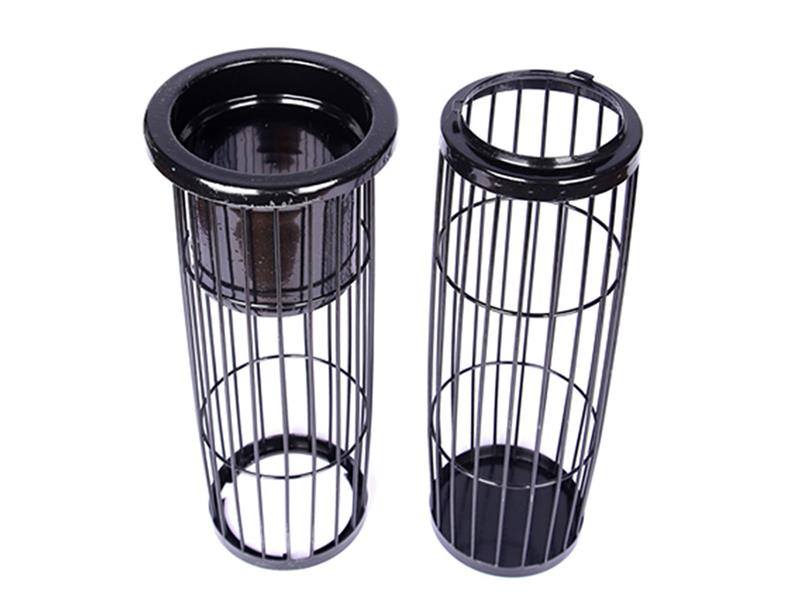The dust-removing skeleton uses a high-frequency welding machine to weld the skeleton once. Use wire or stainless steel wire that meets strength and steel. Galvanized, sprayed, and coated with silicone. The skeleton treated with the silicone skill can completely replace the stainless steel skeleton, which can greatly reduce the protection cost of the equipment. It meets the requirements of lightness, lubrication and straightness, has a rigid planning structure and long service life; it can be customized according to customer needs. In addition, the dust skeleton has different product shapes depending on the field of application. Today we will introduce to us two of the more common ones:
First, the round dust removal skeleton
The round dust-removing skeleton is the rib of the filter bag. It is light and easy to install and protect. The quality of the structure directly affects the filtration condition and service life of the filter bag. The round dust-removing skeleton is the rib of the filter bag. It should be light and easy to install and protect. The quality of the dust-removing skeleton directly affects the filtration condition and service life of the filter bag.
The domestic dust-removing skeleton manufacturer introduces advanced skeleton making equipment, and uses a high-frequency welding machine to weld the skeleton once, and selects a wire or stainless steel wire that satisfies the strength and the steel. Galvanized, sprayed, and coated with silicone. The skeleton treated with the silicone skill can completely replace the stainless steel skeleton, which can greatly reduce the protection cost of the equipment. Moreover, each structure made can meet the requirements of lightness, lubrication and stroke.
The working principle of the circular dust removal skeleton is as follows:
The dusty airflow enters the venturi through the inlet flue, and is uniformly injected into the throat at the entrance of the throat. Because the flue gas moves at a high speed, the injected water is dissolved into a fine mist, which wets the ash in the flue gas. material. In this process, the ash in the flue gas is wetted, so that its weight is increased to facilitate centrifugation. In the case of high-speed flocculation, because of the large difference between water droplets and dust particles, their speed difference is also large. In this way, the ash particles and the water droplets collide and condense, especially the fine dust particles can be dissolved by the water mist, which are fully prepared for the separation of the ash material, and then enter the cylinder. The cylinder is a circular cylinder, and water enters the cylinder from the upper part of the precipitator, so that the inner wall of the cylinder forms a water film flowing from top to bottom. The flue gas is tangentially entered from the lower part of the cylinder and rotates in the cylinder. Ascending, the dust-containing gas always collides with the water film on the inner wall of the cylinder under the action of centrifugal force, so that the dust-containing gas is wetted by the water film, and the dust particles flow with the water to the bottom of the dust collector, are discharged from the overflow hole, and the bottom of the cylinder is sealed at the bottom. A water sealing groove is provided to prevent the flue gas from leaking out from the bottom, and a finishing hole is provided for facilitating the finishing of the bottom of the cylinder. After the dust is removed, the waste water is discharged from the bottom overflow hole into the sedimentation tank, and the precipitate is neutralized and recycled. The purified gas is taken out through the upper cone portion of the cylinder and then reaches the dust removal intention. If you participate in alkaline water in the circulation pool of the dust removal equipment, it can function as a desulfurization dust collector.
Second, trapezoidal dust removal skeleton
The trapezoidal dust-removing skeleton is also called a trapezoidal dust-removing structure and a trapezoidal dust-removing bag cage, which is formed by one-time welding using special equipment. The trapezoidal dust removal skeleton is the rib of the filter bag, and the quality of the skeleton directly affects the working condition and service life of the filter bag. The trapezoidal dust-removing skeleton adopts the skills of silicone spraying or galvanizing and painting, and the coating is firm and corrosion-resistant. It avoids the corrosion of the cage bone surface and the filter bag after a period of operation of the dust collector, ensuring smooth bag change and reducing the bag changing process. Damage to the dust bag.
The trapezoidal dust-removing skeleton adopts a flat structure, the longitudinal reinforcement of the cage bone and the reverse support ring are evenly distributed, and the strength is satisfied, and the damage and deformation of the trapezoidal dust-removing skeleton are prevented from being welded and firm, and the surface is bright and straight. The longitudinal ribs and the backing ring of the cage bone are evenly distributed, and have the strength to meet the damage and deformation of the trapezoidal dust-removing skeleton. The characteristics of the trapezoidal dust-removing skeleton are strong and the surface is bright and the brush does not need unnecessary friction on the filter bag, and the filter bag is improved. Use life. In order to ensure the strength of the steel wire and improve the appearance quality, φ6.5 steel is drawn (pulled into φ2.0), and then the body is assembled on the butt welding tire, and the grinding reaches the skill requirement.

Previous: Jiangsu Jinke teaches you how to make the spring skeleton correctly
下一条: No Information
Address:No. 38, Zhenxing East Road, Banhu Industrial Park, Suining County, Yancheng City, Jiangsu Province 电话:15950316088 MobilePhone:15950316088 E-mail:49362017@qq.com